 Neal Hefti (1922-2008) is best known to many jazz listeners today as Count Basie’s “favorite” arranger. But the remarkably versatile composer and arranger contributed terrifically – and memorably – to a handful of film and television soundtracks during the 1960s that deserve to be much better known today.
Neal Hefti (1922-2008) is best known to many jazz listeners today as Count Basie’s “favorite” arranger. But the remarkably versatile composer and arranger contributed terrifically – and memorably – to a handful of film and television soundtracks during the 1960s that deserve to be much better known today. Born in Hastings, Nebraska, in October 1922, Neal Hefti took up the study of the trumpet in the sixth grade, playing in the high school band and orchestra. Upon moving to New York after graduating high school, Hefti got his first big break playing with Charlie Barnet. By 1942, he played with or made arrangements for Muggsy Spanier, Earl Hines and Bobby Byrne, later joining Charlie Spivak’s orchestra. During this time he scored “Pin-Up Girl,” and played with Horace Heidt on his radio program.
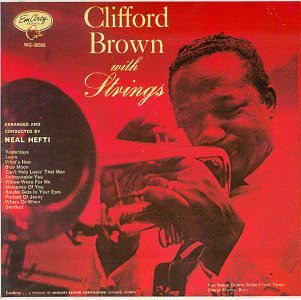 In 1944, Neal Hefti joined Woody Herman and turned in such vivid arrangements as “Caldonia,” “The Good Earth,” “Wildroot,” “Apple Honey,” “Northwest Passage” and others that have since become classics. Hefti later moved to Los Angeles where he worked with Bob Chester and Frank DeVol, but rejoined Herman’s Herd – where he met and married singer Frances Wayne, then vocalist with the orchestra. Hefti worked for two years with Harry James and his orchestra, while providing some of the historic orchestral backgrounds that brought Charlie Parker, Mel Torme and Clifford Brown to wider audiences.
In 1944, Neal Hefti joined Woody Herman and turned in such vivid arrangements as “Caldonia,” “The Good Earth,” “Wildroot,” “Apple Honey,” “Northwest Passage” and others that have since become classics. Hefti later moved to Los Angeles where he worked with Bob Chester and Frank DeVol, but rejoined Herman’s Herd – where he met and married singer Frances Wayne, then vocalist with the orchestra. Hefti worked for two years with Harry James and his orchestra, while providing some of the historic orchestral backgrounds that brought Charlie Parker, Mel Torme and Clifford Brown to wider audiences.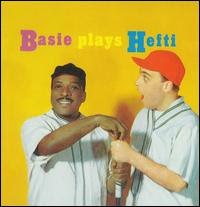 From 1951 until late 1953, Hefti led his own group, the Hefti-Wayne orchestra, often recording under his own name and becoming one of the most sought-after arrangers in jazz. By the mid-fifties, Hefti had begun working with Count Basie, perhaps his best known association. Hefti arranged the Count’s famed April in Paris (Verve, 1956) and provided the entire programs for E=MC2 (aka The Atomic Mr. Basie: Roulette, 1957) and Basie Plays Hefti (Roulette, 1958), yielding several jazz standards in the process, including “Cute,” “Duet,” “Splanky,” “Cherry Point” “Plymouth Rock” and, of course, “Li’l Darlin.” (Hefti later reunited with Basie for the 1962 Verve album On My Way & Shoutin’ Again!).
From 1951 until late 1953, Hefti led his own group, the Hefti-Wayne orchestra, often recording under his own name and becoming one of the most sought-after arrangers in jazz. By the mid-fifties, Hefti had begun working with Count Basie, perhaps his best known association. Hefti arranged the Count’s famed April in Paris (Verve, 1956) and provided the entire programs for E=MC2 (aka The Atomic Mr. Basie: Roulette, 1957) and Basie Plays Hefti (Roulette, 1958), yielding several jazz standards in the process, including “Cute,” “Duet,” “Splanky,” “Cherry Point” “Plymouth Rock” and, of course, “Li’l Darlin.” (Hefti later reunited with Basie for the 1962 Verve album On My Way & Shoutin’ Again!).  By 1960, Hefti had become an executive and artist for Frank Sinatra’s Reprise label, helming the notable Sinatra and Swingin’ Brass (Reprise, 1962) and several of his own albums (Themes From TV’s Top 12, 1961, and Jazz Pops, 1962). He also waxed another album of his own compositions for Harry James called Harry James Plays Neal HeftI (MGM, 1961 – reissued as Harry, Not Jesse for the Metro label in 1965, at the height of Neal Hefti’s film success). Shortly thereafter, Neal Hefti left jazz to quickly earn a reputation as a composer for motion pictures.
By 1960, Hefti had become an executive and artist for Frank Sinatra’s Reprise label, helming the notable Sinatra and Swingin’ Brass (Reprise, 1962) and several of his own albums (Themes From TV’s Top 12, 1961, and Jazz Pops, 1962). He also waxed another album of his own compositions for Harry James called Harry James Plays Neal HeftI (MGM, 1961 – reissued as Harry, Not Jesse for the Metro label in 1965, at the height of Neal Hefti’s film success). Shortly thereafter, Neal Hefti left jazz to quickly earn a reputation as a composer for motion pictures.What follows is an overview of the music that came out of this period, roughly from 1964 to 1968. It’s a lot of music for such a short span of time – and a lot of incredibly good music at that.
 For whatever reason, Neal Hefti didn’t stay long in the Hollywood studios. By 1970, he was working on several television programs and then in 1973 he took a “sabbatical” to undertake concert tours and personal appearances with his own orchestra. During this time he lectured at leading universities as well. He returned to score the completely unknown TV film Conspiracy of Terror (1975) and Won Ton Ton: The Dog Who Saved Hollywood (1976) only to disappear from Hollywood and the music scene forever.
For whatever reason, Neal Hefti didn’t stay long in the Hollywood studios. By 1970, he was working on several television programs and then in 1973 he took a “sabbatical” to undertake concert tours and personal appearances with his own orchestra. During this time he lectured at leading universities as well. He returned to score the completely unknown TV film Conspiracy of Terror (1975) and Won Ton Ton: The Dog Who Saved Hollywood (1976) only to disappear from Hollywood and the music scene forever. Despite the occasional appearance of an arrangement on record (and bands still performing his old arrangements), Neal Hefti never again composed or recorded under his own name after the records presented here, even though he died some three decades later on October 11, 2008, in Los Angeles, California, a mere 18 days before his 86th birthday.
 Sex and the Single Girl (LP = Warner Bros., 1964/CD = Film Score Monthly, 2007): Neal Hefti’s first film score - not counting his contributions to the 1957 film Jamboree - was for this forgotten “sex comedy” based on Helen Gurley Brown’s 1962 book (which, inexplicably, inspired the 2003 Ewan McGregor/Renee Zellweger film Down with Love that gets a zingy Marc Shaiman score that has its roots in Hefti’s sparkly jazz), starring Tony Curtis, Natalie Wood, Henry Fonda, Lauren Bacall and Mel Ferrer. The breezy soundtrack, as per usual for the time, is presented completely out of order for the film, but unquestionably shows how the great jazz composer/arranger Neal Hefti was not only perfectly well suited to light Hollywood fare but magically able to take this sort of thing up a notch or two with his superb sense of melody and jazz fortitude.
Sex and the Single Girl (LP = Warner Bros., 1964/CD = Film Score Monthly, 2007): Neal Hefti’s first film score - not counting his contributions to the 1957 film Jamboree - was for this forgotten “sex comedy” based on Helen Gurley Brown’s 1962 book (which, inexplicably, inspired the 2003 Ewan McGregor/Renee Zellweger film Down with Love that gets a zingy Marc Shaiman score that has its roots in Hefti’s sparkly jazz), starring Tony Curtis, Natalie Wood, Henry Fonda, Lauren Bacall and Mel Ferrer. The breezy soundtrack, as per usual for the time, is presented completely out of order for the film, but unquestionably shows how the great jazz composer/arranger Neal Hefti was not only perfectly well suited to light Hollywood fare but magically able to take this sort of thing up a notch or two with his superb sense of melody and jazz fortitude. Director Richard Quine (1920-89) provides the title song, voiced – startlingly well - by the film’s star, Fran Jeffries (vocalist of Mancini’s “It Had Better Be Tonight” from The Pink Panther, married to former Harry James vocalist and actor Dick Haymes at the time and later to become, for a period of time, Mrs. Quine – also the ex-mother-in-law of my favorite wordsmith, Bernie Taupin!), and given a swinging big-band arrangement by Neal Hefti. Ms. Jeffries also features on the Al Jolson standard, “Anniversary Waltz,” on which she is backed in the film by the orchestra of Hefti’s former boss, Count Basie. But it’s unlikely that the Count or his Orchestra is performing the music heard in the film or the soundtrack.
While Buddy Collette (1921-2010) is credited as the swinging, effervescent flautist here, there is a prominent use of harpsichord throughout which helps keep the mood jaunty and light, yet never ironic or jokey. The unnamed guitarist helps set an appropriately “delightful” mood as well. Highlights are plentiful and include “Midnight Swim,” the Odd Couple-template of “City Style” (also a great feature for Buddy Collette), the great “I’ve Got Love,” the charming source cue “I Must Know” (offering a scintillating use of strings) and the instrumental version of the title track, which seems to be the foundation for Hefti’s forthcoming “Girl Talk.”
Novelist Joseph Heller was one of the writers of this film’s script and the director, Richard Quine, would go on to direct a TV film version of Heller’s well-known Catch-22 (1973). Hefti would also score go on to score Quine’s films How To Murder Your Wife (1965), Synanon (1965) and Oh Dad, Poor Dad, Mamma’s Hung You in the Closet and I’m Feeling So Sad (1967), all of which had soundtrack releases. Film Score Monthly’s 2007 CD release of Sex and the Single Girl also includes Leonard Rosenman’s notable and somewhat related 1962 soundtrack to The Chapman Report.
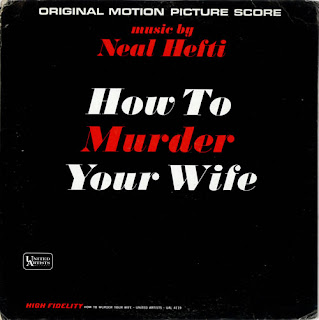 How To Murder Your Wife (LP = United Artists, 1965/CD = Film Score Monthly, 2008; Kritzerland, 2009): In his second film for director Richard Quine, Neal Hefti comes up with a superbly sparkling and entrancingly jazzy score filled with memorable moments and what amounts to no less than a signature sound. It’s what Henry Mancini might have come up with had he taken things in more of a jazz direction in his own films. Yes, there is jazzy instrumentation present here and even an unbelievably large quantity of interesting improvisation. But there is also a lot of music in How To Murder Your Wife, writer/producer George Axelrod’s surprisingly sexist and mostly misogynist story starring Jack Lemmon as cartoonist Stanley Ford – famed puzzler of the Bash Brannigan comic strip series – who accidentally and drunkenly marries the beautiful Virna Lisi after seeing her pop out of a cake at a friend’s bachelor party. The story is preposterous on so many levels that it can be nothing more than a male’s revenge fantasy. Unfortunately it leads to a bit too many unrealistically goofy sequences, scored appropriately enough by Hefti in too much of a Keystone Kops manner (“Suspicion,” “Stag Party Blast,” “Bash Brannigan,” “Cartoon Capers”). Several themes on the soundtrack album get unnecessary vocals they do not have in the film (“Here’s To My Lover,” “Stag Party Blast,” the absolutely goofy “How To Murder Your Wife,” which is otherwise scored gorgeously by Hefti, and the strangely drunken “Requiem for a Bachelor” which has only a brief instrumental respite in the film).
How To Murder Your Wife (LP = United Artists, 1965/CD = Film Score Monthly, 2008; Kritzerland, 2009): In his second film for director Richard Quine, Neal Hefti comes up with a superbly sparkling and entrancingly jazzy score filled with memorable moments and what amounts to no less than a signature sound. It’s what Henry Mancini might have come up with had he taken things in more of a jazz direction in his own films. Yes, there is jazzy instrumentation present here and even an unbelievably large quantity of interesting improvisation. But there is also a lot of music in How To Murder Your Wife, writer/producer George Axelrod’s surprisingly sexist and mostly misogynist story starring Jack Lemmon as cartoonist Stanley Ford – famed puzzler of the Bash Brannigan comic strip series – who accidentally and drunkenly marries the beautiful Virna Lisi after seeing her pop out of a cake at a friend’s bachelor party. The story is preposterous on so many levels that it can be nothing more than a male’s revenge fantasy. Unfortunately it leads to a bit too many unrealistically goofy sequences, scored appropriately enough by Hefti in too much of a Keystone Kops manner (“Suspicion,” “Stag Party Blast,” “Bash Brannigan,” “Cartoon Capers”). Several themes on the soundtrack album get unnecessary vocals they do not have in the film (“Here’s To My Lover,” “Stag Party Blast,” the absolutely goofy “How To Murder Your Wife,” which is otherwise scored gorgeously by Hefti, and the strangely drunken “Requiem for a Bachelor” which has only a brief instrumental respite in the film). The delightful main title sequence, narrated (at length) by Terry-Thomas’ surprisingly over-devoted manservant “Charles,” is tremendously scored by Hefti as a medley of no less than six of the composer’s themes for the film. The original soundtrack album, re-recorded by the composer for LP release (and issued on CD by both Film Score Monthly and Kritzerland), captures a five-and-a-half minute rendition of this suite. The Kritzerland CD, which adds the film’s original score to the LP soundtrack that was released at the time, stretches this suite to the six minutes (!) that the titles unwind during the film – showing one of the most magnificent New York City townhouses ever captured on camera.
How To Murder Your Wife Is positively brimming with highlights and includes the classy and superbly melodic “Here’s to My Lover,” which has not gotten the due in jazz that it truly deserves (the Kritzerland CD includes the film’s beautiful instrumental version of this tune), the fantastically swinging and resourcefully jazzy “Scene of the Crime” (my favorite moment here - a jazz version of the main theme that’s heard during the film’s party sequence – the original take is included as part of the long cue called “The Party” on the Kritzerland CD), “Virna,” the dreamy theme named for the film’s Italian star that reveals the not-too-future “Mrs. Ford” emerging from a cake wearing strategically placed whipped cream, and even the re-recorded “Comic Capers” has much worthy Mancini-esque melody to offer soundtrack listeners.
The original soundtrack of How To Murder Your Wife was issued by Film Score Monthly in 2008 as part of their 12-disc The MGM Soundtrack Treasury along with Hefti’s soundtrack for Duel at Diablo. In 2009, Kritzerland, issued the full 54-minute score to How To Murder Your Wife - which had never been issued before – along with the (re-recorded) music from the 29-minute soundtrack album, paired, more logically, with Hefti’s soundtrack for Lord Love A Duck, also written and produced (and, in this case, directed) by George Axelrod.
 Synanon (Liberty, 1965): The third of director Richard Quine’s five collaborations with composer Neal Hefti is this unusually sober (pardon the pun) account of the famed Synanon House in Santa Monica, California, a rehabilitation home for victims of heroin addiction, alcoholism and juvenile delinquency. It was the Betty Ford Clinic of its day and one of the first places that heroin addicts could even go for help with recovery from “dope” addiction.
Synanon (Liberty, 1965): The third of director Richard Quine’s five collaborations with composer Neal Hefti is this unusually sober (pardon the pun) account of the famed Synanon House in Santa Monica, California, a rehabilitation home for victims of heroin addiction, alcoholism and juvenile delinquency. It was the Betty Ford Clinic of its day and one of the first places that heroin addicts could even go for help with recovery from “dope” addiction.Quite a few jazz artists came and went through Synanon House, famously called “a tunnel back to life,” and, of course, jazz came to be film and TV’s musical shorthand for drug use before rock came along in the psychedelic sixties. Jazz is how filmmakers conveyed their (or their audience’s) disapproval of drug use, allowing improvisation and wildly out of control saxophones or drums to provide the sense of unbalance and discord of the drug user. I guess I disapprove of jazz being tied to drug use or out-of-control lifestyles. At best, I sense a justification with these sorts of associations to put down jazz and, at worst, a bizarre sense of racism, discrimination or even disapproval of some sort.
It’s something of a surprise to find Neal Hefti providing a jazz score to this film. It suggests that he either agreed with the negative musical stereotype (which I can’t believe) or was just doing what he was asked to do. The music Hefti provides is better-than-average small-group jazz, helmed in most cases by one or more unnamed Hammond B-3 organists. But whatever the tempo, it all stays within the melodic framework Hefti’s compositions are known for. They swing, they just swing. And the soloists barely wander beyond the melody. There’s no wild life here.
The main theme, “Zankie,” given three performances here (the jazz version toward the end of side two is the one to hear), suggests the unfunny side of “The Odd Couple” while “Blues for Hopper” and the orchestral “Tonight’s the Night” display initial signs of the go-go rock Hefti would soon perfect with the “Batman Theme.”
While the dreadful and drunken-sounding pieces vocalized by the choir, “Main Street” (with lyrics probably by Hefti himself) and “The Whiffenpoof Song,” are regrettable inclusions, Synanon includes several remarkable Hefti highlights including “The Perfect Beginning,” the lovely “Hope” (which deserves to be much better known) and “Open House,” on which I swear organist Shirley Scott, long a fan and performer of Count Basie and Neal Hefti tunes, is playing. Neither essential nor easy to find, Synanon still provides these several moments that rank high among Neal Hefti’s musical output.
 Harlow (LP = Columbia Masterworks, 1965/CD = DRG, 2003): This big-budget Hollywood epic has everything: a terrific cast of b-listers and great character actors, the always engaging behind-the-scenes glimpse of Hollywood hucksters and wannabes behaving badly, terrific sets on a ridiculously grand scale and the absolutely terrific music of Neal Hefti. If you can get past the camp and enjoy the trashy, sugar-coated Hollywood myth-making/heart-breaking machinery and the stilted acting forced on the cast by scriptwriter John Michael Hayes’ (probably required) sanitizing of some pretty awful stories (making the story anything but biographical), Harlow is a true delight of Mommie Dearest proportions. What stands out in particular, though, is Neal Hefti’s remarkable score. As the LP jacket says, “[h]is music evokes the gaiety and sadness, the golden triumph of success, the tinsel and the tears that were so much a part of Harlow’s meteoric career.” Indeed. It is a score of prototypical Hollywood glitz and glamour with a substantial undertow of exceptionally strong melodies and remarkably engaging orchestration.
Harlow (LP = Columbia Masterworks, 1965/CD = DRG, 2003): This big-budget Hollywood epic has everything: a terrific cast of b-listers and great character actors, the always engaging behind-the-scenes glimpse of Hollywood hucksters and wannabes behaving badly, terrific sets on a ridiculously grand scale and the absolutely terrific music of Neal Hefti. If you can get past the camp and enjoy the trashy, sugar-coated Hollywood myth-making/heart-breaking machinery and the stilted acting forced on the cast by scriptwriter John Michael Hayes’ (probably required) sanitizing of some pretty awful stories (making the story anything but biographical), Harlow is a true delight of Mommie Dearest proportions. What stands out in particular, though, is Neal Hefti’s remarkable score. As the LP jacket says, “[h]is music evokes the gaiety and sadness, the golden triumph of success, the tinsel and the tears that were so much a part of Harlow’s meteoric career.” Indeed. It is a score of prototypical Hollywood glitz and glamour with a substantial undertow of exceptionally strong melodies and remarkably engaging orchestration.Harlow is home to Hefti’s now-standard “Girl Talk.” The song, which briefly accompanies a glamour montage in the film, got a set of amazingly sexist lyrics from pianist Bobby Troup and has since become a jazz standard covered by nearly everyone including Hefti’s former employers Harry James (The Ballads and the Beat!) and Count Basie (Basie Swingin’, Voices Singin’).
The main theme, the extraordinarily lovely “Lonely Girl,” deserves to be as familiar as “Girl Talk.” It has received far too little jazz coverage but worthy versions have been recorded by the likes of Harold Vick (Straight Up), Pete Jolly (Herb Alpert Presents Pete Jolly), Francy Boland/Kenny Clarke (Griff ‘n’ Bags, credited to Johnny Griffin, and Going Classic), Dorothy Ashby (Afro-Harping), Tony Bennett & Bill Evans (Together Again) and Earl Klugh (The Earl Klugh Trio Volume 1). The soundtrack provides the initial track “Lonely Girl – Main Title,” voiced by a typically Mancini-esque Hollywood choir, but the actual track that is heard during the main titles is titled simply “Lonely Girl” on the album (track 8 on the CD). The bossa nova rhythm underpins a sumptuous melody that unfolds slowly and plaintively and blazing with drama, much like the flower of the character Hefti is writing for.
A number of other terrific Hefti moments are also present here: “Blues for Jean,” “Scrambled Eggs” and the terrifically titled “Carroll Baker A Go Go” in particular. The weakest link here, though, is Hefti’s embarrassing lyric to the otherwise decent “Waltz for Jeannie,” sung to excess by the choir. No doubt Hefti was positively inspired by Jean Harlow – and Carroll Baker’s touching performance – enough to compose “Lonely Girl.” It’s a shame to hear it put into words for a song.
The 2003 DRG CD release of Harlow adds an alternate vocal version of “Lonely Girl,” delivered in a slightly more bossa-nova style (mixing the “Main Title” vocal version with the actual main title version) but, surprisingly, does not add the Bobby Vinton version of the song which played over the film’s end credits. Vinton’s version, for whatever reason, was also not included on the original Columbia soundtrack but rather issued on an Epic 45 that reached 61 on the Billboard Hot 100 in 1965 (it also appears on the Vinton album Drive-In Movie Time). Vinton was probably chosen as the vocalist for “Lonely Girl” as he was known at the time for hits like “L-O-N-E-L-Y,” “Mr. Lonely” and a 1965 album of tunes about loneliness called Bobby Vinton Sings For Lonely Nights. We can only imagine what would have happened had the crooner of Frank Sinatra Sings for Only the Lonely crooned this one.
 The Leisurely Loveliness of Neal Hefti and his Orchestra (Movietone, 1965): This excellent yet too little-known record of Neal Hefti compositions “featuring two dozen violins, troops of flutes & a hip harpsichord” was recorded around 1964 or 1965 while the composer was firmly ensconced in Hollywood, doing scores for major motion pictures.
The Leisurely Loveliness of Neal Hefti and his Orchestra (Movietone, 1965): This excellent yet too little-known record of Neal Hefti compositions “featuring two dozen violins, troops of flutes & a hip harpsichord” was recorded around 1964 or 1965 while the composer was firmly ensconced in Hollywood, doing scores for major motion pictures. Issued for some reason on the nearly unknown Movietone Records label, a budget division of 20th Century Fox Records - whose music is now owned by Universal Music - The Leisurely Loveliness shows both sides of Hefti’s magnificent significance – first as a composer of notable and memorable tunes and, second, as a terrifically inventive orchestrator of music that really sparkles. If sparkling music needs clarified for any reason, let me add that I find music that “sparkles“ like this enchanting enough to revisit time and again and appreciate each time as a new journey into sound. It’s meant, for purposes of clarity, as a complement, not as something derogatory. It sparkles with wit and verve and musical invention that are all too rare.
While no one will mistake these performances for jazz, it doesn’t much matter or make this lovely music, intended to sound lovely, any less worthy or satisfying. The album is crafted in the manner of many of Henry Mancini’s many RCA albums of the period, with a thematic disposition (jazz originals) and a certain musical flavor (in this case, strings, flutes, harpsichord and percussion – a captivating combination). It’s one way some of the more clever music producers introduced jazz into many American households at the time.
Here, Hefti provides a cross-section of some of his well-known originals from the Count Basie book like “Cute,” “Duet,” “Li’l Darlin’,” “Late Date,” “Scoot,” “Pensive Miss,” “Nice To Be With You” (known otherwise as “It’s Awfully Nice To Be With You”) and “Rose Bud.” Additionally, Hefti contributes a new take on his classic chart “Repetition,” which Charlie Parker wanted to be a part of and, naturally, later immortalized.
There’s also a piece Hefti provided to Harry James, the great “Sunday Mornin’” (for whatever reason, the “g” at the end of “Morning” was dropped from the tune’s first appearance) and one new track on the collection, the exquisite and exceptional “Should I Or Shouldn’t I,” a gorgeously romantic offering for which Hefti actually wrote (quite good) lyrics that are not performed here. “Should I Or Shouldn’t I” deserves to be much better known. In the hands of a great vocalist it could be quite striking – and in the hands of a contemporary orchestra, would revive another great Hefti number worthy of great attention.
The difficult-to-find The Leisurely Loveliness of Neal Hefti and his Orchestra, none of which, to my knowledge, has ever seen the light of day on CD, is an absolute gem and will be appreciated by those who admire Neal Hefti’s musical jazziness, jazzy film music and the swinging sultriness of Neal Hefti.
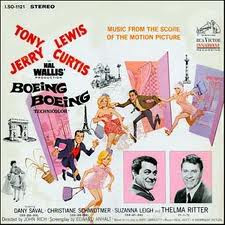 Boeing, Boeing (RCA, 1965): Neal Hefti’s music for this Jerry Lewis/Tony Curtis sex comedy is the closest the composer ever came to sounding like Henry Mancini, whose comedy scores of the time were the classy standard of sparkling invention – seriously hip and brimming over with musical misadventure. What separates the two composers most, perhaps, is that the Mancini-scored comedies, while probably not considered too terribly funny today, are not as dated and as sexist as the more suggestive Hefti-scored sex comedies. Maybe that is why Neal Hefti got out of film. He was definitely becoming typecast into this sort of thing.
Boeing, Boeing (RCA, 1965): Neal Hefti’s music for this Jerry Lewis/Tony Curtis sex comedy is the closest the composer ever came to sounding like Henry Mancini, whose comedy scores of the time were the classy standard of sparkling invention – seriously hip and brimming over with musical misadventure. What separates the two composers most, perhaps, is that the Mancini-scored comedies, while probably not considered too terribly funny today, are not as dated and as sexist as the more suggestive Hefti-scored sex comedies. Maybe that is why Neal Hefti got out of film. He was definitely becoming typecast into this sort of thing. The preposterous film, which (seriously) lists the actresses’ physical measurements as part of the credit sequence, takes place for the most part in Paris. As a result, Hefti provides a number of comically French cliché motifs to go along with the action. Commendably, though, Hefti traverses the road less travelled by providing a worldly musical travelogue without using the standard instrumentation – something which raises this music a few bars above forgettable or regrettable. In this case, he presents an American organ tuned to sound European, much like an accordion, and a steely guitar to suggest everything from a zither to a bouzouki. It’s a nice touch that allows some of the music to stand nicely on its own, apart from the dreadful film it’s a part of.
Even with 12 tracks, though, there’s only about 25 minutes of music here; most of it on the comic-movie side with regrettably little to recommend the soundtrack album other than “Vikki (We Are Engaged, Aren’t We?),” the very Mancini-esque waltz “Champagne Promises (Embracing With The Moon)” and the dark and brooding “Bavarian Pipe Dream (Happy Titfallgit-Luganandeplatz),” which, surprisingly, prefigures both Mancini’s 1968 Wait Until Dark theme “Theme for Three” and, more notably, the 1971 theme to The Night Visitor.
 Batman Theme and 19 Hefti Bat Songs (Razor & Tie, 1997): In 1965, producer William Dozier commissioned composer Neal Hefti to conceive the theme to a new TV show he was developing based on the Bob Kane comic strip Batman. "(It was the) hardest piece I ever wrote," Hefti commented in retrospect. Try as he might, for six weeks he couldn't find a tune catchy enough. He never had an inspirational moment. When he finally brought the score to the show's producers, he said he went into the meeting "... reluctantly, apologetically, shuffling my feet and looking like Tom Sawyer. I thought they would throw it back in my face."
Batman Theme and 19 Hefti Bat Songs (Razor & Tie, 1997): In 1965, producer William Dozier commissioned composer Neal Hefti to conceive the theme to a new TV show he was developing based on the Bob Kane comic strip Batman. "(It was the) hardest piece I ever wrote," Hefti commented in retrospect. Try as he might, for six weeks he couldn't find a tune catchy enough. He never had an inspirational moment. When he finally brought the score to the show's producers, he said he went into the meeting "... reluctantly, apologetically, shuffling my feet and looking like Tom Sawyer. I thought they would throw it back in my face."Hefti's fears were unfounded. The pulsating, powerful "go-go" style big-band piece was a hit with the producers. Even better, the song won the Grammy award for Best Instrumental Song in 1966. The “Batman Theme" turned into a top-10 instrumental hit for the Marketts and even Hefti’s version cracked the Billboard Top 40.
For whatever reason, Hefti was only asked to provide the theme for the show. The great Nelson Riddle provided the underscore to the series as well as the 1966 Batman film, utilizing the primary style of Hefti’s main theme and enhancing it with his own jazz-inflected touches.
 An album of Hefti originals called Batman Theme and 11 Hefti Bat Songs (RCA, 1966) was issued to take advantage of the theme’s success. But while the record is too often dismissed as “not the soundtrack” to the show, it does provide a brilliantly re-recorded jazz version of “Batman Theme” and “The Batusi” – both used in the show – and ten very similarly conceived themes that sure sound as if they could have come from the show.
An album of Hefti originals called Batman Theme and 11 Hefti Bat Songs (RCA, 1966) was issued to take advantage of the theme’s success. But while the record is too often dismissed as “not the soundtrack” to the show, it does provide a brilliantly re-recorded jazz version of “Batman Theme” and “The Batusi” – both used in the show – and ten very similarly conceived themes that sure sound as if they could have come from the show. It’s hard to dismiss the brilliant blend of go-go rock and brassy jazz that Hefti conceives here and not appreciate the perfect marriage of music he creates. Prior to the “Batman Theme,” rock-n-roll scoring in TV and film was pretty anachronistic and probably few rock listeners would have taken the music very seriously even though, admittedly, this particular music has its tongue firmly in its cheek.
Not surprisingly, the “Batman Theme” changed the way film and TV composers incorporated rock sounds into their scores. Overall, the album varies the style and the mood enough to stay interesting. I swear keys, time signatures and beats per minute are all the same throughout, though! Highlights here include “Evil Plot to Blow up Batman,” “Sewer Lady,” “The Mafista,” “Just A Simple Millionaire,” “My Fine Feathered Finks,” “Mr. Freeze,” the great Booker T-like “Jervis” and “Batman Chase,” a great theme-based groove featuring a funky organ solo.
 A second album followed shortly thereafter, Hefti in Gotham City (RCA, 1966), to help exploit Hefti’s hit theme (not included here) and the show’s unbelievable, though short-lived success. Titles notwithstanding, the music here is only conceived as Batman-like music or music inspired by the show as the theme’s suddenly popular composer was being billed now as Neal “Batman Theme” Hefti. I’m sure he loved that as much as a fellow trumpeter – also recording for RCA at the time – loved being called Al “He’s The King” Hirt.
A second album followed shortly thereafter, Hefti in Gotham City (RCA, 1966), to help exploit Hefti’s hit theme (not included here) and the show’s unbelievable, though short-lived success. Titles notwithstanding, the music here is only conceived as Batman-like music or music inspired by the show as the theme’s suddenly popular composer was being billed now as Neal “Batman Theme” Hefti. I’m sure he loved that as much as a fellow trumpeter – also recording for RCA at the time – loved being called Al “He’s The King” Hirt.This second Hefti-oriented Batman album differs quite a bit from the first. Things are just as swinging and jazzy as before, if not more so, with an electric bass and an aggressive drummer providing the propulsive four-on-the-floor rock groove throughout. But, Hefti shifted here into more of the orchestral thought pattern he knew best here.
In general Hefti’s probably a far more interesting tunesmith than Nelson Riddle - though both successfully arranged for Frank Sinatra. Riddle provided, perhaps, more of the “underscoring” the singer needed than did Hefti, who was interested in more orchestral inflections than a strong leading vocalist would allow.
One could surmise this is how Neal Hefti might have crafted the Batman underscore or the caped crusader’s movie had he desired or been given the opportunity. It’s more melodic, brassier (Riddle focused on winds) and allows considerably more space for musical invention than Riddle is known for. Maybe this is why Hefti was perfect for scoring a memorable TV theme but wrong for scoring a TV show (though, to be fair, Hefti was musical director onThe Kate Smith Show, The Fred Astaire Show and scored several episodes of The Odd Couple).
Highlights here include “Honorable Batman” (getting an Asiatic twist via a strategically utilized gong), the groovy “Robin’s Egg Blues,” the great “Mother Gotham,” which is as close to a marriage of “Batman” and “The Odd Couple” as anyone is likely to ever hear, “Fingers” (great organ) and the groovy “Soul City.”
In 1997, Razor & Tie combined these two LPs to form the CD Batman Theme and 19 Hefti Bat Songs, more or less mimicking the unbelievably generic cover art of the first of the two RCA LPs. But, sadly, now even this disc is out of print – an undeserving fate to some typically terrific music Neal Hefti laid down, regardless of whether or not this music is “official” soundtrack music. A CD of Batman Theme and 11 Hefti Bat Songs is probably still easy to find at a pretty reasonable price.
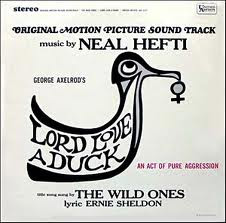 Lord Love A Duck (LP = United Artists, 1966/CD = Kritzerland, 2009): George Axelrod’s bizarre satire of the mid 1960s Southern California lifestyle (and, probably more disturbingly to many, contemporary middle American values) is one of those now forgotten oddities that those few of a certain age either love (like other such satires of the time as Dr. Strangelove or the great The Loved One) or hate. On the other hand it reunited the producer/director with his How to Murder Your Wife collaborator, Neal Hefti. Oddly, the composer is called upon to come up with a relentless rock-n-roll soundtrack filled with twangy guitars, comping organs and three-chord vamps. It’s an unexpectedly inelegant assignment for a gifted composer capable of elegantly mixing jazz with orchestral music so effortlessly.
Lord Love A Duck (LP = United Artists, 1966/CD = Kritzerland, 2009): George Axelrod’s bizarre satire of the mid 1960s Southern California lifestyle (and, probably more disturbingly to many, contemporary middle American values) is one of those now forgotten oddities that those few of a certain age either love (like other such satires of the time as Dr. Strangelove or the great The Loved One) or hate. On the other hand it reunited the producer/director with his How to Murder Your Wife collaborator, Neal Hefti. Oddly, the composer is called upon to come up with a relentless rock-n-roll soundtrack filled with twangy guitars, comping organs and three-chord vamps. It’s an unexpectedly inelegant assignment for a gifted composer capable of elegantly mixing jazz with orchestral music so effortlessly. The intent was probably to provide a parody of rock music, otherwise any number of legit surf bands, The Ventures or even Booker T. and the M.G.’s could have contributed something more appealing to the audience the film intended to reach. Here, Hefti provides a remarkably annoying main theme (“hey hey hey”) that gets some truly awful lyrics by Ernie Sheldon (recommended to Hefti by Elmer Bernstein after Baby, The Rain Must Fall and composer of the lyrics to Hefti’s Duel at Diablo theme) and voiced by 1960s one near-hit wonder The Wild Ones. A secondary theme, the equally repetitious “The Wedding,” is, like the main theme, repeated endlessly throughout the film and the soundtrack too. Curiously, hypnosis is one of the film’s subtle and more interesting themes and Hefti’s repetitious and (too) oft-repeated musical motifs drive this home. The film’s only other notable themes are the similarly devised “Balboa Blast” and “All Night Long (Part I)” (both from the beach party dance scenes), “The Year of the Duck” and “All Night Long (Part II).”
Although Batman debuted on television a month before Lord Love A Duck was released in movie theaters, it’s a safe bet that Hefti wrote the Duck score before the Batman theme. Duck has much of the comic edge of Hefti’s Batman theme but little of Batman’s wit or sense of rock invention. The Lord Love A Duck soundtrack – which sounds like the film’s actual score, such as it is, not a then-typical re-recording – was issued on CD in 2009 by Kritzerland on CD with Hefti’s score and soundtrack for How To Murder Your Wife.
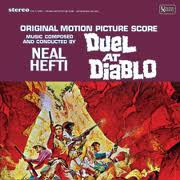 Duel at Diablo (LP = United Artists, 1966/CD = Film Score Monthly, 2008): While nearly every film composer in the 1950s and 60s was required to score at least one anachronistic and bewilderingly popular Western-oriented film, many made not only a career out of it (Dimitri Tiomkin) but some even did something new and different with this genre music (Ennio Morricone, Jerry Goldsmith). Composer Neal Hefti scored only one Western film in his entire career, director Ralph Nelson’s 1966 film Duel at Diabo, a seemingly timely ode to racial intolerance, starring the superb James Garner and – inexplicably – the always great Sidney Poitier, previously in Nelson’s Lilies of the Field. Hefti, too, offered something different.
Duel at Diablo (LP = United Artists, 1966/CD = Film Score Monthly, 2008): While nearly every film composer in the 1950s and 60s was required to score at least one anachronistic and bewilderingly popular Western-oriented film, many made not only a career out of it (Dimitri Tiomkin) but some even did something new and different with this genre music (Ennio Morricone, Jerry Goldsmith). Composer Neal Hefti scored only one Western film in his entire career, director Ralph Nelson’s 1966 film Duel at Diabo, a seemingly timely ode to racial intolerance, starring the superb James Garner and – inexplicably – the always great Sidney Poitier, previously in Nelson’s Lilies of the Field. Hefti, too, offered something different.Duel at Diablo director Ralph Nelson formerly helmed the award-winning TV film Requiem for a Heavyweight (1959) and directed films that often got the best from such jazz-oriented composers as Henry Mancini (Soldier in the Rain), Lalo Schifrin (Once a Thief, The Wrath of God), Roy Budd (Soldier Blue, Flight of the Doves) and Tom McIntosh (A Hero Ain’t Nothin’ But A Sandwich). This particular Western, aside from the charismatic performances of strong leads including Garner, Poitier, Bibi Andersson (just before she made Ingmar Bergman’s timeless Persona) and Dennis Weaver, tackles racism and sexism in fascinating ways that don’t stint on the sort of action that most film viewers would have wanted to see in this sort of film.
Hefti’s score hardly ever resorts to the typical “wild wild west” film music either. The main theme is wistful and Western without ever sounding clichéd or self-mocking. There’s plenty of electric guitar and motivating percussion throughout and particularly notable is the poetic use of the vibraphone. Duel is certainly not as jazzy as the music Hefti had previously contributed to film. But this music is also considerably darker and more dramatic than any of the lighter fare proffered on previous Hefti scores, something certainly in keeping with the film’s serious themes.
Hefti does an excellent job providing the right musical mood and atmosphere for the film. It is probably Hefti’s least appreciated score. But it is absolutely right for the film and very highly regarded by many of the film’s fans who know nothing of Neal Hefti or his other musical work. It also provides a number of interesting moments including the galvanizing “Main Theme,” which gets a number of variations throughout, including “Ellen’s Theme,” “Bullets and Beans,” which may be said to foreshadow Lalo Schifrin’s “Burning Bridges” (from Kelly’s Heroes), the jazz-rock of “Rescue From Ritual” and the dramatic, though very filmic “Fight at Diablo Pass.”
The soundtrack of Duel at Diablo was issued by Film Score Monthly in 2008 as part of their 12-disc and now out-of-print The MGM Soundtrack Treasury along with Hefti’s soundtrack forHow To Murder Your Wife.
 Definitely Hefti! (United Artists, 1967): A compilation of previously released Neal Hefti themes from three United Artists film soundtracks: How To Murder Your Wife (“Here’s To My Lover,” “Requiem For A Bachelor” and “How To Murder Your Wife”), Lord Love A Duck (“Lord Love A Duck,” “The Wedding” and “All Night Long (Part 1)”) and Duel at Diablo (“Ellen’s Theme,” “Rescue From Ritual,” “The Earth Runs Red,” “Dust to Dust” and “Duel at Diablo”). Not the most cohesive collection to be sure and, not surprisingly, never issued on CD.
Definitely Hefti! (United Artists, 1967): A compilation of previously released Neal Hefti themes from three United Artists film soundtracks: How To Murder Your Wife (“Here’s To My Lover,” “Requiem For A Bachelor” and “How To Murder Your Wife”), Lord Love A Duck (“Lord Love A Duck,” “The Wedding” and “All Night Long (Part 1)”) and Duel at Diablo (“Ellen’s Theme,” “Rescue From Ritual,” “The Earth Runs Red,” “Dust to Dust” and “Duel at Diablo”). Not the most cohesive collection to be sure and, not surprisingly, never issued on CD.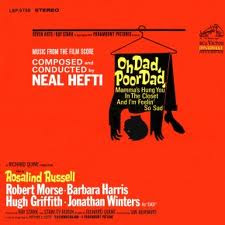 Oh Dad, Poor Dad, Mamma’s Hung You In The Closet And I’m Feelin’ Sad (RCA, 1967): This film, based on the surprisingly successful 1962 Off-Broadway play of the same name, was apparently completed in 1965 but not released until early 1967 – owing to the studio’s indecision to properly market the off-off-beat comedy.
Oh Dad, Poor Dad, Mamma’s Hung You In The Closet And I’m Feelin’ Sad (RCA, 1967): This film, based on the surprisingly successful 1962 Off-Broadway play of the same name, was apparently completed in 1965 but not released until early 1967 – owing to the studio’s indecision to properly market the off-off-beat comedy. Directed by Richard Quine (with uncredited additions from the great Alexander Mackendrick, who probably directed the Jonathan Winters scenes added later), the odd Oh Dad, Poor Dad stars Rosalind Russell, Robert Morse (best known today from Mad Men) and Barbara Harris. It’s hard to say at what point Neal Hefti’s fun little score was added – but it was clearly after Batman as such themes as the last third of “Home Movies,” “The Revolt of Jonathan Rosepettle III” and “This is Mother” will attest (the music also predates the Sesame Street motif occasionally heard throughout).
The film’s main theme, voiced nicely by a children’s choir, is a rather fun little romp of delightful melody (and sparkling counter melody) paired with comic sensibility (repeated on the second third of “Home Movies,” “Oh Dad Calypso” and “Oh Dad, Poor Dad”). The film is inexplicably filmed in picturesque Montego Bay, Jamaica and inspires Hefti to provide some nicely tropical music, including the wonderful secondary theme “Boy-Girl Calypso,” hardly a calypso, but nevertheless a great melody reprised on the first third of “Home Movies,” the charming samba variation of “Theme for a Boy and Girl” and “Spooky Coffins.”
This is one of Neal Hefti’s scores that I really love, though some may take exception to the repeated thematic variations and the occasional Batman vibe. The themes are terrifically engaging and varied enough to stay interesting. And who wouldn’t want to hear Hefti do more of his Batman thing? Highlights of the score include the Batman sounding “This is Mother” and, one of my Hefti favorites, the delightful flute-led “Oh Dad Calypso.” Reissued on CD in 1999.
 Barefoot in the Park (Dot, 1967): Of the two Neil Simon film adaptations directed by Gene Saks that composer Neal Hefti did the theme for, the first of them, Barefoot in the Park, is the least known (The Odd Couple is the other). Barefoot in the Park, like The Odd Couple, was even turned into a TV show in 1970, though it only lasted for less than one season and is also as forgotten as the film that starred young up and comers Robert Redford and Jane Fonda. Like The Odd Couple, the briefly-aired Barefoot in the Park TV series also used Hefti’s movie theme as the series’ theme.
Barefoot in the Park (Dot, 1967): Of the two Neil Simon film adaptations directed by Gene Saks that composer Neal Hefti did the theme for, the first of them, Barefoot in the Park, is the least known (The Odd Couple is the other). Barefoot in the Park, like The Odd Couple, was even turned into a TV show in 1970, though it only lasted for less than one season and is also as forgotten as the film that starred young up and comers Robert Redford and Jane Fonda. Like The Odd Couple, the briefly-aired Barefoot in the Park TV series also used Hefti’s movie theme as the series’ theme. Here, Hefti conceives a theme in jazz-waltz time that’s especially light on its feet. That may be due to the gently comic lyrics provided to the tune by the legendary Johnny Mercer and vocalized three times by an anonymous choir (“Main Title,” “Barefoot in the Park (Vocal)” and the 30-second “End Title”) on this soundtrack album. The theme has all the grandeur of any of Mancini’s lighter fare of the period (Breakfast at Tiffany’s, Charade) that a romance of a newly wedded couple of opposites would inspire to a great musical thinker like Neal Hefti.
Lovely as it is, though, the main theme (which has been covered by Horst Jankowski, Charlie Byrd and Earl Klugh) is reprised a bit too often for an album that plays for under half an hour. Still, it receives some particularly lovely adaptations (“Barefoot in the Park (Instrumental),” the brief orchestral version “The Barefoot Stumbler” – my favorite – the symphonic bossa version “Mom Arrives for Dinner,” the bachelor-pad take of “New Home Up-A-Stairs,” “Journey to the Four Winds” and the spy jazz take of “A Nut on the Roof”), most often voiced exquisitely by the alto sax of the great Bud Shank, often heard on many film soundtracks of the period. The saxophonist is also nicely featured on the brief “Two O’clock Capers” and “Blues for Paul” as well.
Hefti’s musical genius is especially apparent throughout this brief but engaging album on the lovely orchestration of the “Main Title,” “A Nut on the Roof,” the lullaby-like “Corie Grows Up” and “Six Flights Up,” the story’s running gag.
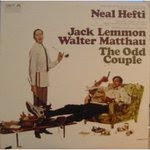 The Odd Couple (Dot, 1968): One of Neal Hefti’s two best-known tunes is his delightfully rollicking theme to this 1968 Gene Saks-directed film starring Jack Lemmon and Walter Matthau (based on the successful 1965 stage play directed by Mike Nichols and originally starring Art Carney and Walter Matthau), which became the theme to the incredibly popular TV series of the same name, starring Tony Randall and Jack Klugman, who replaced Matthau in the stage play, which ran on ABC-TV from 1970 through 1975 (and helped nab Neal Hefti two Grammy Award nominations).
The Odd Couple (Dot, 1968): One of Neal Hefti’s two best-known tunes is his delightfully rollicking theme to this 1968 Gene Saks-directed film starring Jack Lemmon and Walter Matthau (based on the successful 1965 stage play directed by Mike Nichols and originally starring Art Carney and Walter Matthau), which became the theme to the incredibly popular TV series of the same name, starring Tony Randall and Jack Klugman, who replaced Matthau in the stage play, which ran on ABC-TV from 1970 through 1975 (and helped nab Neal Hefti two Grammy Award nominations).There’s not much to the 1968 Dot soundtrack album other than the theme and a number of variations, including a bizarre vocal version with surprisingly off-beat lyrics provided by the otherwise brilliant Sammy Cahn (and featured on the great CD The Mad, Mad World of Soundtracks Volume 2), and a bunch of “excerpts of comedy” allegedly taken from the film. I have never seen the film, but the audience sounds – laughs and cheers – make the whole thing rather perplexing.
It’s a shame there’s just not more music here. Unfortunately, this album contains less than 20 minutes of Hefti’s gloriously constructed compositions, including the great main theme, its variations, the sinewy film funk of “Metropole,” the bouncy “Tomatoes” and the jazzy bossa of “Man Chases Man,” offering a great organ solo that promises more than the album delivers. Hefti varies the theme a number of times here, but the exceptional “Down with the Lights” changes up the tempo and the time signature enough to suggest how amazingly adaptable it is to other considerations (a Hefti trademark).
Not sure how much Hefti music was provided for the film – he actually scored several episodes of the TV show as well – but it would be nice to hear more Hefti and less comedy here.
Neal Hefti’s terrific main titles sequence for the 1968 George Peppard thriller P.J.


4 comments:
Great blog post.
If you would like an alternative to randomly picking up girls and trying to figure out the right thing to do...
If you would prefer to have women hit on YOU, instead of spending your nights prowling around in crowded bars and night clubs...
Then I urge you to watch this eye-opening video to learn a weird secret that has the power to get you your very own harem of hot women:
FACEBOOK SEDUCTION SYSTEM...
Great blog -
looking for sidemen lists.
Guessing 'usual suspects',
i.e., L.A. studio guys.
Unlike all of the wonderful Man from U.N.C.L.E. soundtracks, FSM's "Sex & the Single Girl" CD album is a BIG rip off as it has none of the original and far superior session takes used for the movie. Were the original analog or digitized mag tape or film masters really not available?
Post a Comment